

Mennonite Colonies
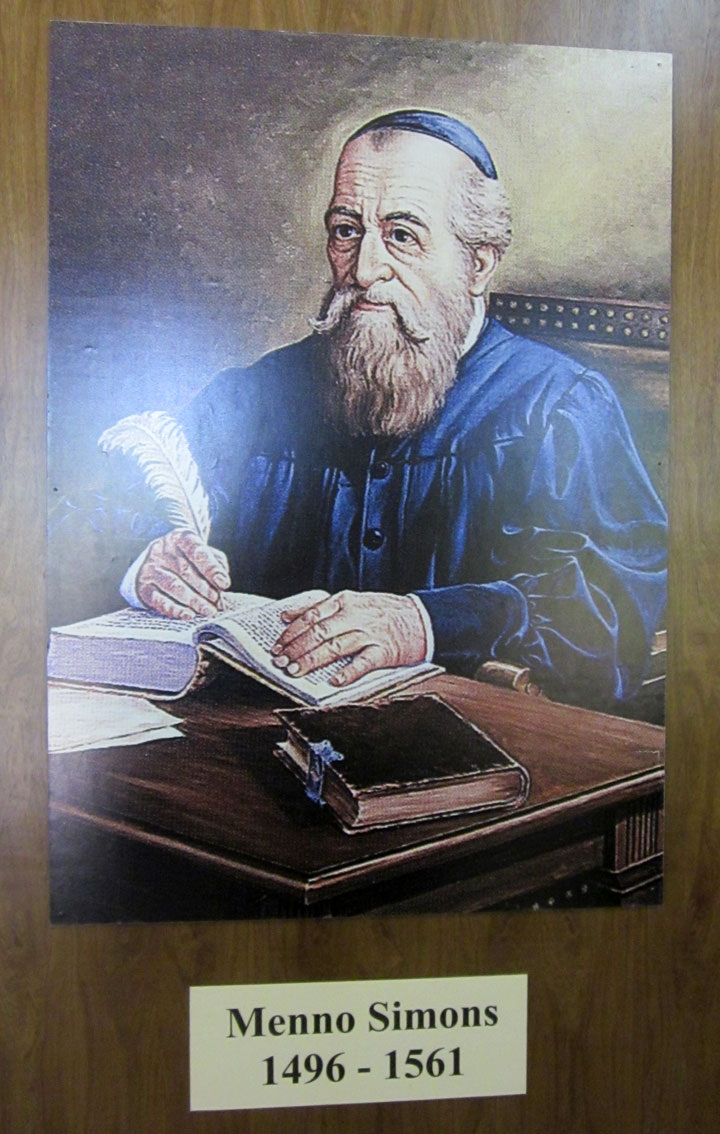
German speaking Anabaptist
The Russian Mennonites are a group of
Mennonites descended from Dutch and mainly Germanic Prussian Anabaptists who
established colonies in South Russian Empire (present-day Ukraine) beginning in
1789. Since the late 19th century, many of them have come to countries
throughout the Western Hemisphere. The rest were forcibly relocated, so that few
of their descendants now live at the location of the original colonies. Russian
Mennonites are traditionally multilingual with Plautdietsch (Mennonite Low
German) as their lingua franca.
In the early-to-mid 16th century, Mennonites began to move from the Low
Countries (especially Friesland) and Flanders to the Vistula delta region,
seeking religious freedom and exemption from military service. They gradually
replaced their Dutch and Frisian languages with the Plautdietsch dialect spoken
in the area, blending into it elements of their native tongues. Plautdietsch is
the distinct Mennonite language which developed over a period of 300 years in
the Vistula delta region and south Russia.

flight from Russia
In 1772, most of the Mennonites' land in the Vistula area became part of Prussia
in the first of the Partitions of Poland. Frederick William II of Prussia
ascended the throne in 1786 and imposed heavy fees on the Mennonites in exchange
for continued military exemption.
Catherine the Great of Russia issued a Manifesto in 1763 inviting all Europeans
to come and settle various pieces of land within Russia, especially in the Volga
River region. For a variety of reasons, Germans responded to this in large
numbers. Mennonites from the Vistula delta region of Prussia later sent
delegates to negotiate an extension of this Manifesto and, in 1789, Crown Prince
Paul signed a new agreement with them. The Mennonite migration to Russia from
Prussia was led by Jacob Hoeppner and Johann Bartsch. Their settlement territory
was northwest of the Sea of Azov, and had just been acquired from the Ottoman
Empire in the Russo-Turkish War, 1768-1774. Many of the Mennonites in Prussia
accepted this invitation, establishing Chortitza on the Dnieper River as their
first colony in 1789. A second larger colony, Molotschna, was founded in 1803.
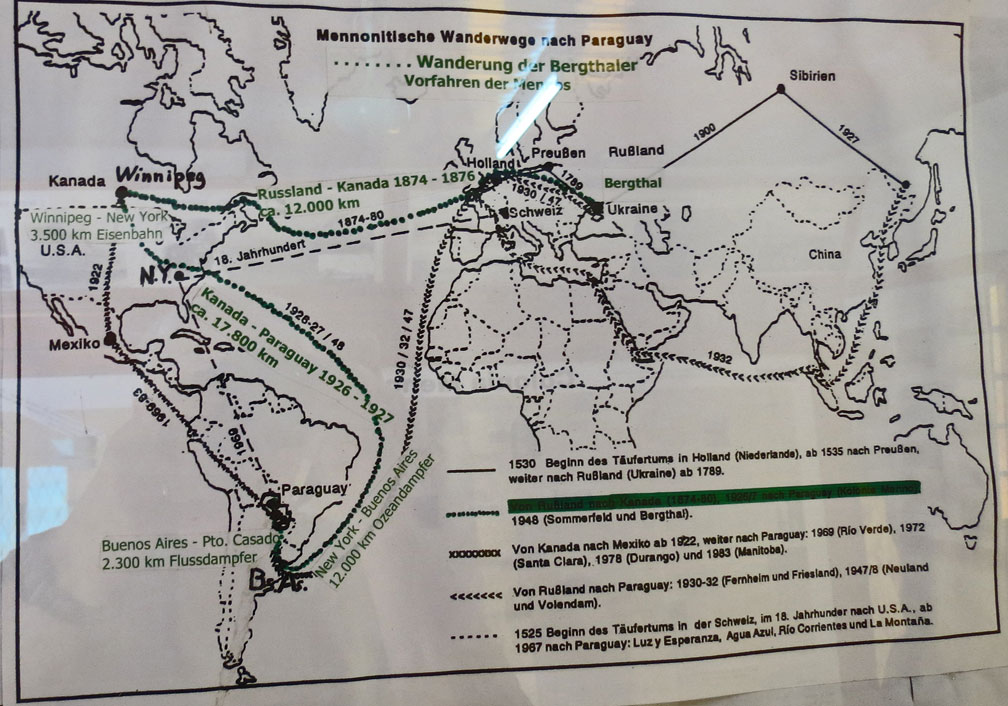
migration route to Paraguay
Mennonites lived alongside Nogais - semi-nomadic pastoralists - in the Molochna
region of southern Ukraine starting from 1803, when Mennonites first arrived,
until 1860, when the Nogai Tatars departed. Mennonites provided agricultural
jobs to Nogais and rented pasture from them. Nogai raids on Mennonite herds were
a constant problem in the first two decades of settlement.
Two Mennonite settlements on the Vistula near Warsaw, Deutsch-Kazun and Deutsch-Wymysle,
came under Russian control when the border was readjusted at the Congress of
Vienna. Some of these families emigrated to the Molotschna settlement after it
was established. Deutsch-Michalin near Machnovka was founded in 1787. Many
families from this settlement moved to nearby Volhynia in 1802. Swiss Mennonites
of Amish descent from Galicia settled near Dubno, Volhynia province in 1815.
Other Galician Mennonites lived near Lemberg.
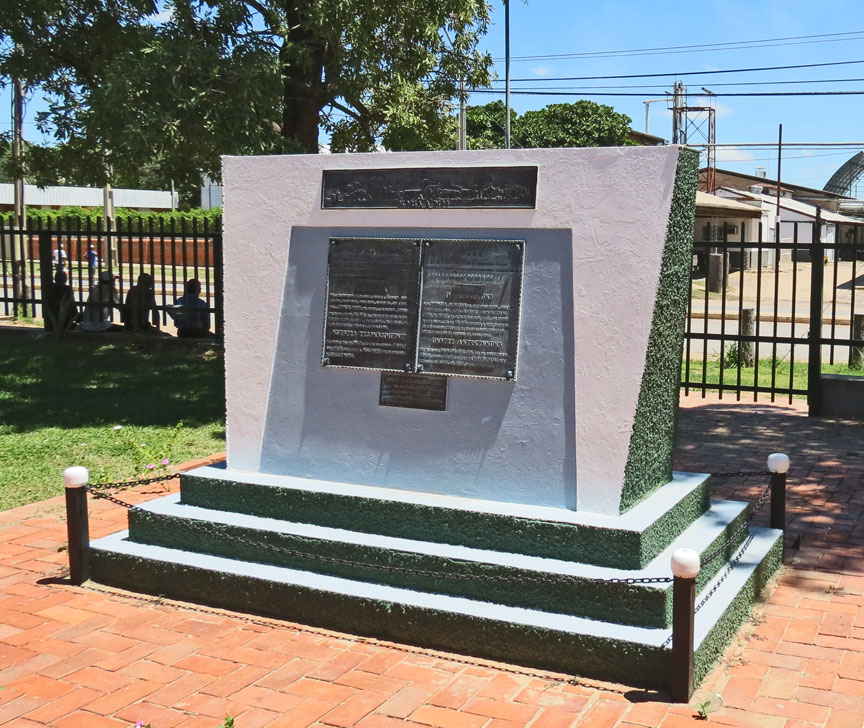
50th Anniversary of arrival in Paraguay
When the Prussian government eliminated exemption from military service on
religious grounds, the remaining Mennonites were eager to emigrate to Russia.
They were offered land along the Volga River in Samara and exemption from
military service for twenty years, after which they could pay a special
exemption tax. Two settlements, Trakt and Alt-Samara (to distinguish it from Neu
Samara Colony), were founded in 1853 and 1861 respectively.
By 1870 about 9000 individuals had immigrated to Russia, mostly to the Chortitza
and Molotschna settlements which, with population increase, numbered about
45,000. Forty daughter colonies were established by 1914 occupying nearly 12,000
km² (4500 mi²) with a total population of 100,000.

The colonists formed villages of fifteen to thirty families, each with 70 ha
(175 acres) of land. The settlements retained some communal land and a common
granary for use by the poor in lean years. Income from communal property
provided funding for large projects, such as forming daughter colonies for the
growing population.
Initially the settlers raised cattle, sheep and general crops to provide for
their household. The barren steppes were much drier than their Vistula delta
homeland and it took years to work out the proper dryland farming practices.
They grew mulberries for the silk industry, produced honey, flax and tobacco,
and marketed fruits and vegetables for city markets. By the 1830s wheat became
the dominant crop.
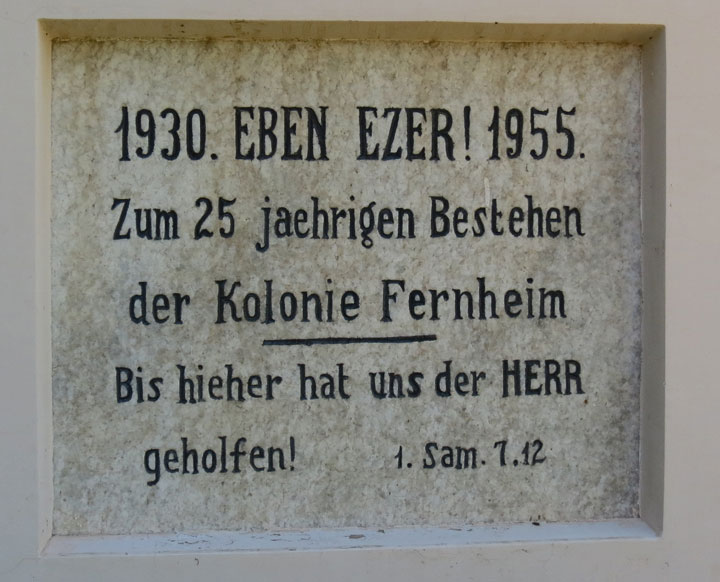
Expanding population and the associated pressure for more farmland became a
problem by 1860. The terms of the settlement agreement prevented farms from
being divided; they were required to pass intact from one generation to the
next. Since agriculture was the main economic activity, an expanding class of
discontented, landless poor arose. Their problems tended to be ignored by the
village assembly, which consisted of voting landowners. By the early 1860s the
problem became so acute that the landless organized a party that petitioned the
Russian government for relief. A combination of factors relieved their plight.
The Russian government permitted farms to be divided in half or quarters and
ordered release of the village's communal land. The colonies themselves
purchased land and formed daughter colonies on the eastern frontier extending
into Siberia and Turkestan. These new colonies included Bergtal, Neu Samara
Colony and the Mennonite settlements of Altai.
As wheat farming expanded, the demand for mills and farm equipment grew. The
first large foundry was established in Chortitza in 1860 and other firms
followed. By 1911 the eight largest Mennonite-owned factories produced 6% of the
total Russian output (over 3 million rubles), shipped machinery to all parts of
the empire and employed 1744 workers. The annual output of Lepp and Wallman of
Schönwiese was 50,000 mowers, 3000 threshing machines, thousands of gangplows in
addition to other farm equipment. Flour and feed mills were originally
wind-powered, a skill transplanted from Prussia. These were eventually replaced
with motor and steam driven mills. Milling and its supporting industries grew to
dominate the industrial economy of the colonies and nearby communities.
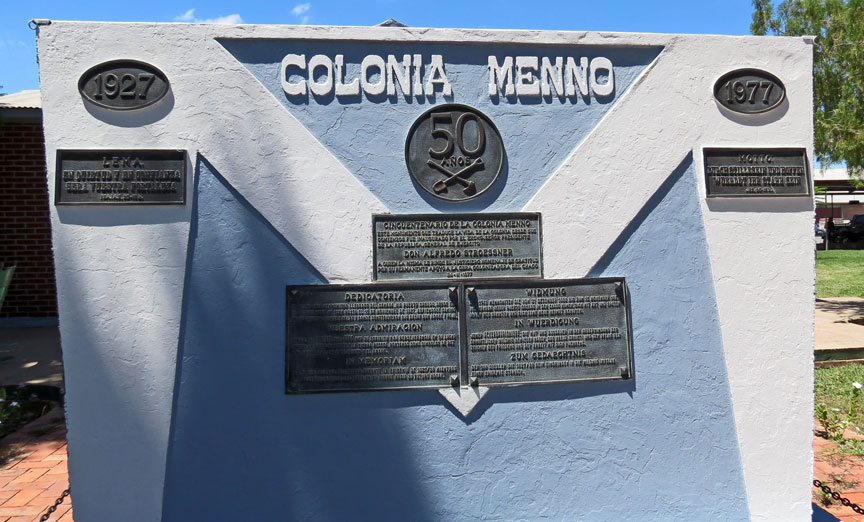
Mennonite colonies were self-governing with little intervention from the Russian
authorities. The village, the basic unit of government, was headed by an elected
magistrate who oversaw village affairs. Each village controlled its own school,
roads and cared for the poor. Male landowners decided local matters at village
assemblies.
Villages were grouped into districts. All of the Chortitza villages formed one
district; Molotschna was divided into two districts: Halbstadt and Gnadenfeld. A
district superintendent headed a regional bureau that could administer corporal
punishment and handle other matters affecting the villages in common. Insurance
and fire protection were handled at the regional level, as well as dealing with
delinquents and other social problems. The Mennonite colonies functioned as a
democratic state, enjoying freedoms beyond those of ordinary Russian peasants.

In addition to village schools, the Mennonite colonies established their own
hospitals, a mental hospital and a school for the deaf. They cared for orphans
and elderly and provided an insurance program. By being largely self-sufficient
in these local matters, they were able to minimize their burden on and contact
with the Russian government.
Mennonites stayed out of Russian politics and social movements that preceded the
Russian revolution. After the Russian Revolution of 1905 they did exercise their
right to vote. Most aligned themselves with the Octobrist Party because of its
guarantee of religious freedoms and freedom of the press for minority groups.
Abraham Bergmann was an Octobrist member of the Third and Fourth State Dumas;
Peter Schröder, a Constitutional Democratic party member from Crimea, was a
member of the fourth Duma.
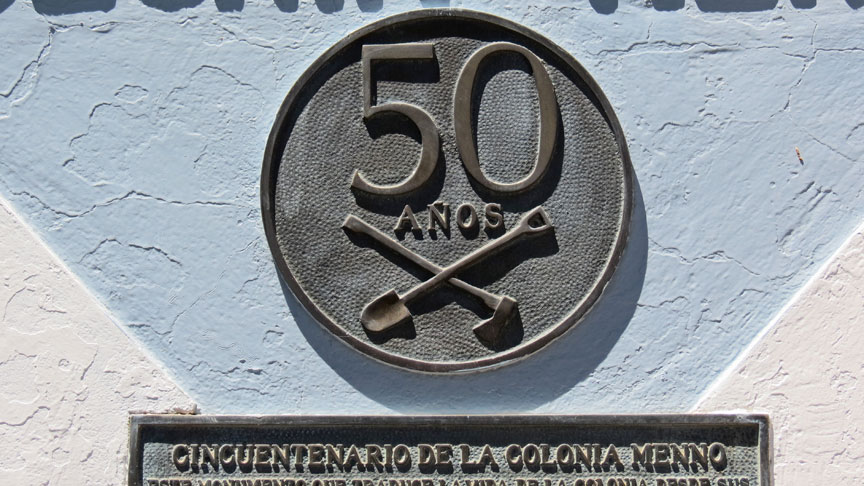
At a time when compulsory education was unknown in Europe, the Mennonite
colonies formed an elementary school in each village. Students learned practical
skills such as reading and writing German and arithmetic. Religion was included
as was singing in many schools. The teacher was typically a craftsperson or
herder, untrained in teaching, who fit class time around his occupation.
In 1820 the Molotschna colony started a secondary school at Ohrloff, bringing a
trained teacher from Prussia. The Central School was started in Chortitza in
1842. Over three thousand pupils attended the Central School with up to 8% of
the colonists receiving a secondary education. A school of commerce was
started in Halbstadt employing a faculty with full graduate education. Those who
wanted to pursue post-secondary education attended universities in Switzerland,
Germany as well as Russia.
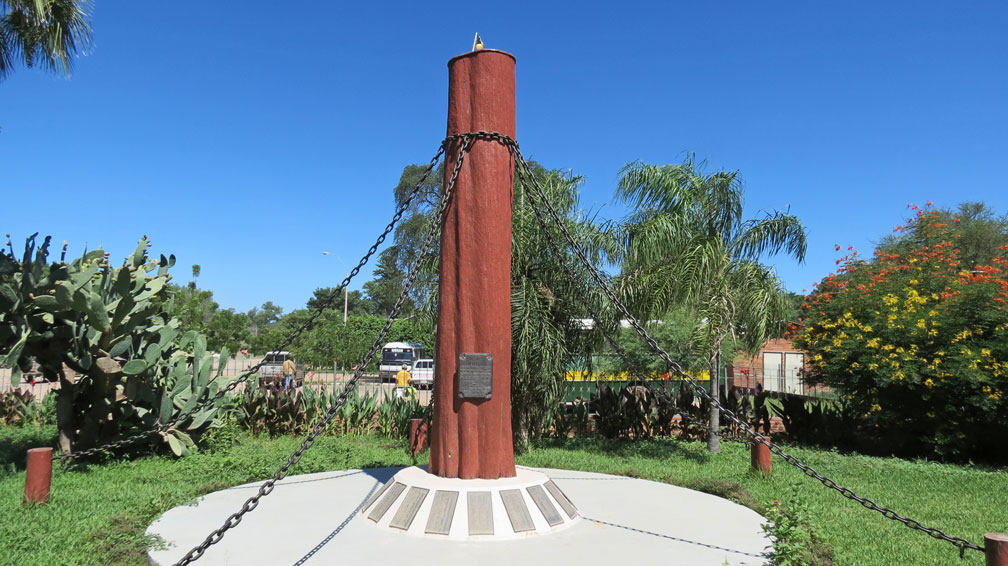
Typically each village or group of villages organized an independent
congregation. Cultural and traditional differences between Frisian, Flemish and
West Prussian Mennonites were also reflected in the their churches. They all
agreed on fundamental Mennonite beliefs such as believer's baptism,
nonresistance and avoidance of oaths. Pastors of Flemish congregations read
sermons from a book while seated at a table. Frisian pastors stood while
delivering the sermon.
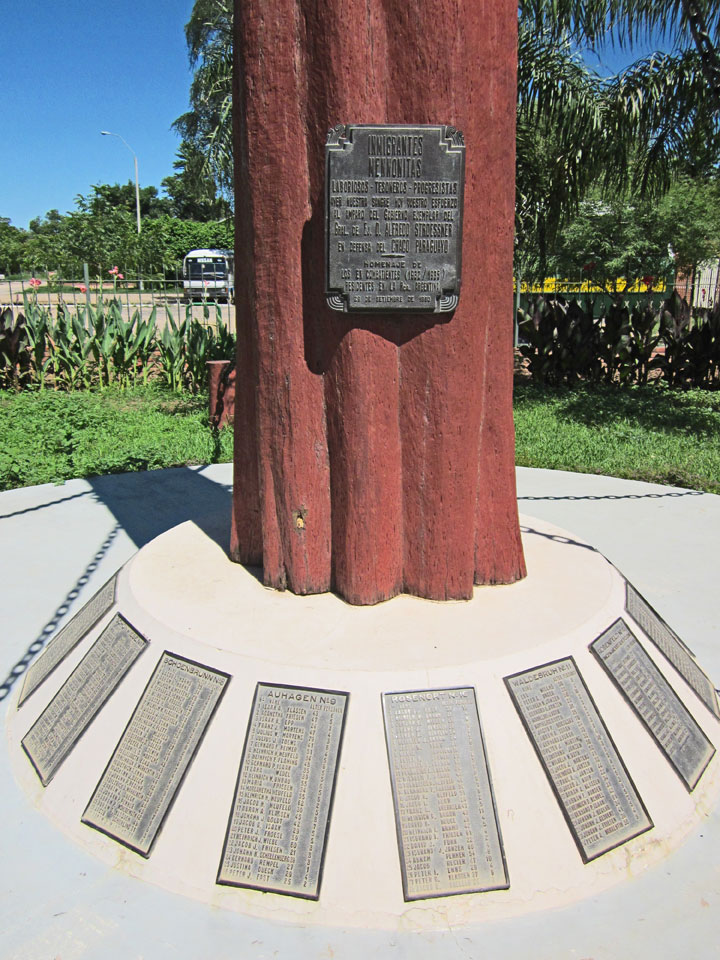
Pastors were untrained and chosen from within the congregation. Unpaid pastors
were selected from among the wealthier members—large landowners, sometimes
teachers—allowing them to make a living while serving the congregation. The
combined effect of respect for their position and material wealth gave them
substantial influence over the community. The religious and secular leadership
within a village often colluded against the poorer members.
Church discipline was exercised in the form of excommunication against those
committing gross sins. The most conservative congregations practiced avoidance
which entailed cutting all business and social ties with an unrepentant member.
Because being part of a Mennonite congregation was required to enjoy the special
benefits the Russian government provided to colonists, excommunication had
broader implications. This was softened by the various internal factions, which
allowed a person banned from one congregation to join another.
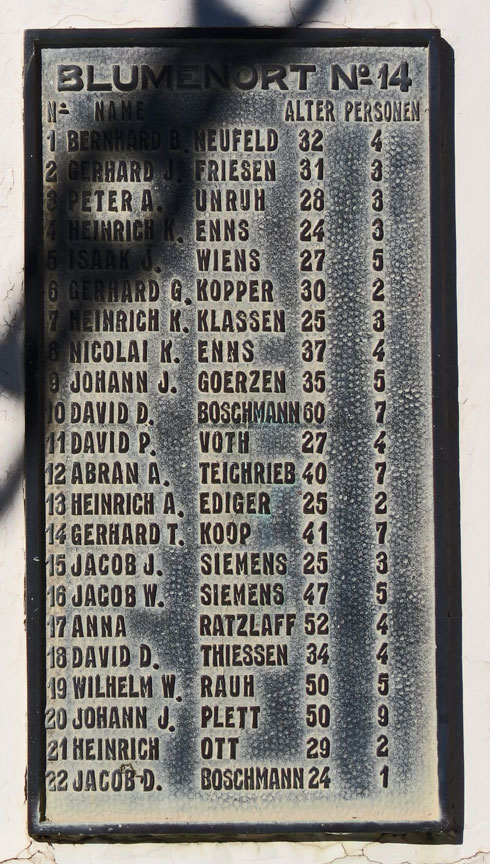
names of immigrants from Russia
Klaas Reimer and a group of eighteen followers broke from the main group and formed the Kleine Gemeinde. Reimer's main complaint was that Mennonite leaders were straying from their traditional nonresistant stance when they turned lawbreakers over to the government for punishment while at the same time church leaders were lax in enforcing spiritual discipline. In 1860 a portion of this group moved to Crimea, adopted baptism by immersion and became known as the Krimmer Mennonite Brethren.
Pietistic influences, introduced earlier among the West Prussian Mennonites, were transplanted to the Molotschna colony. The pastor of a neighboring congregation, Eduard Wüst, reinforced this pietism. Wüst was a revivalist who stressed repentance and Christ as a personal savior, influencing Catholics, Lutherans and Mennonites in the area. He associated with many Mennonite leaders, including Leonhard Sudermann.
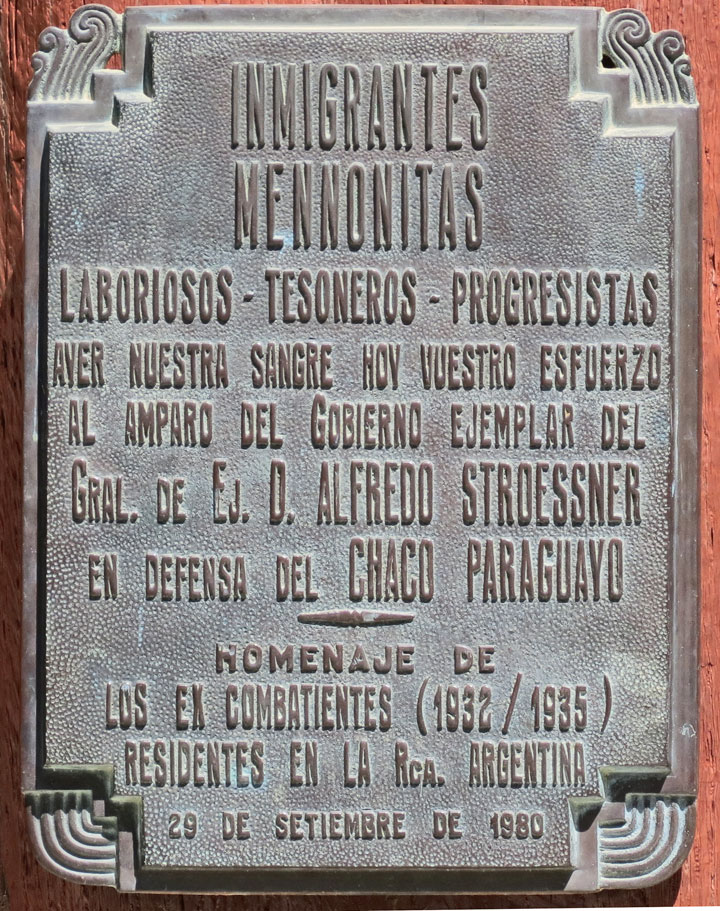
In 1859, Joseph Höttmann, a former associate of Wüst met with a group of
Mennonites to discuss problems within the main Mennonite body. Their discussion
centered on participating in communion with church members who were unholy or
not converted and baptism of adults by immersion.
The Mennonite Brethren Church formally broke with the main church on 1860-01-06
when this growing group of dissenters presented a document to the elders of the
Molotschna Mennonite Churches which indicated "that the total Mennonite
brotherhood has decayed to the extent that we can no more be part of it" and
fear the "approach of an unavoidable judgment of God." The Mennonite Brethren
movement spread throughout the Mennonite colonies and produced many
distinguished leaders, particularly in Molotschna. By breaking religious and
cultural patterns that had become a hindrance to Mennonite society, the
contribution of the Mennonite Brethren allowed all Mennonites groups to pursue a
more wholesome Christian life.
The main body of Mennonites continued to be congregational in organization until
1882 when the General Conference of Mennonite Congregations in Russia was
formed. Cooperation among Mennonite congregations throughout the empire became
necessary for dealing with common interests such as publishing a hymnal,
adopting a confession of faith, preserving the German language, education and
running the forestry service, an alternative to military service. The conference
adopted the motto Unity in essentials, tolerance in non-essentials, moderation
in all things.
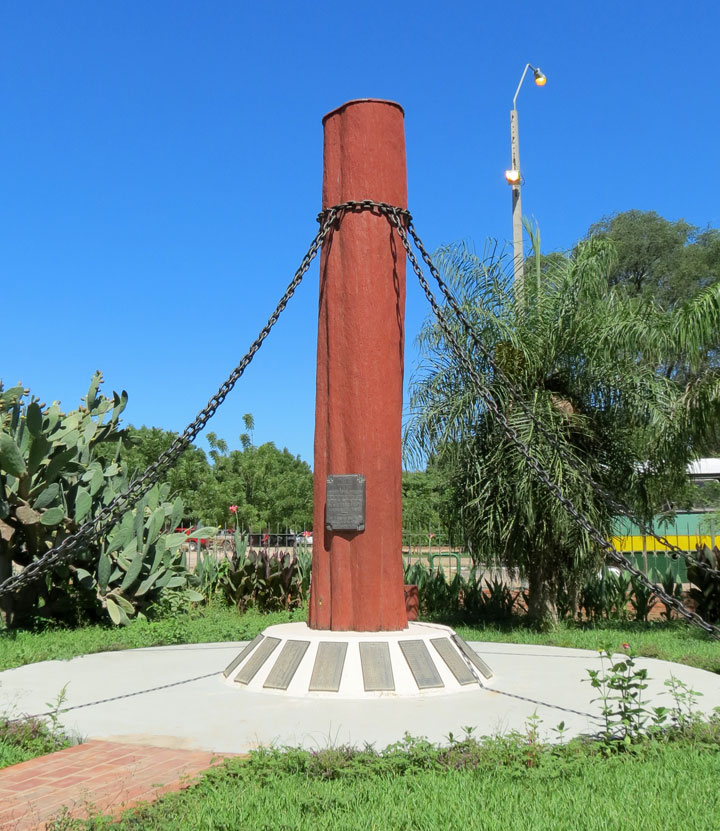
The Russianization program of Stolypin required the conference to publish its
proceedings in Russian, certify all delegates with the imperial government and
allow a government representative to attend all sessions. The conference found
itself devoting more time to dealing with changing government policies and
protecting the special privileges of Mennonites. An important task was to
convince the government that Mennonitism was an established religion and not a
sect, a label applied to small religious groups who were regularly mistreated
within the Russian empire.
As nationalism grew in central Europe, the Russian government could no longer
justify the special status of its German colonists. In 1870 they announced a
Russification plan that would end all special privileges by 1880. Mennonites
were particularly alarmed at the possibility of losing their exemption from
military service and their right for schools to use the German language, which
they believed was necessary to maintain their cultural and religious life.
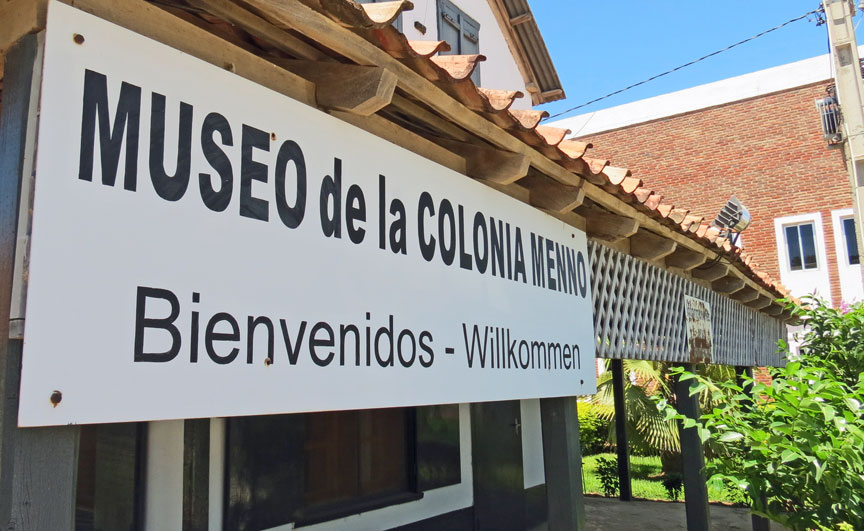
Delegates were sent to Petersburg in 1871 to meet with the czar and appeal for
relief on religious grounds. They met with high officials, but failed to present
the czar with their petition. A similar attempt the next year was also
unsuccessful, but were assured by the Tsar's brother Grand Duke Konstantin that
the new law would provide a way to address the concerns of the Mennonites in the
form of noncombatant military service.
The most conscientious Mennonites could not accept any form of service that
supported warmaking, prompting their community leaders to seek immigration
options. In 1873 a delegation of twelve explored North America, seeking large
tracts of fertile farmland. This group consisted of Leonhard Sudermann and Jacob
Buller of the Alexanderwohl congregation representing the Molotschna settlement;
Tobias Unruh from Volhynia settlements; Andreas Schrag of the Swiss Volhynia
congregations; Heinrich Wiebe, Jacob Peters and Cornelius Buhr from the Bergthal
Colony; William Ewert from West Prussia; Cornelius Toews and David Classen of
the Kleine Gemeinde and brothers Paul and Lawrence Tschetter representing the
Hutterites. This group returned with positive reports of good land available in
Manitoba, Minnesota, South Dakota, Nebraska and Kansas.
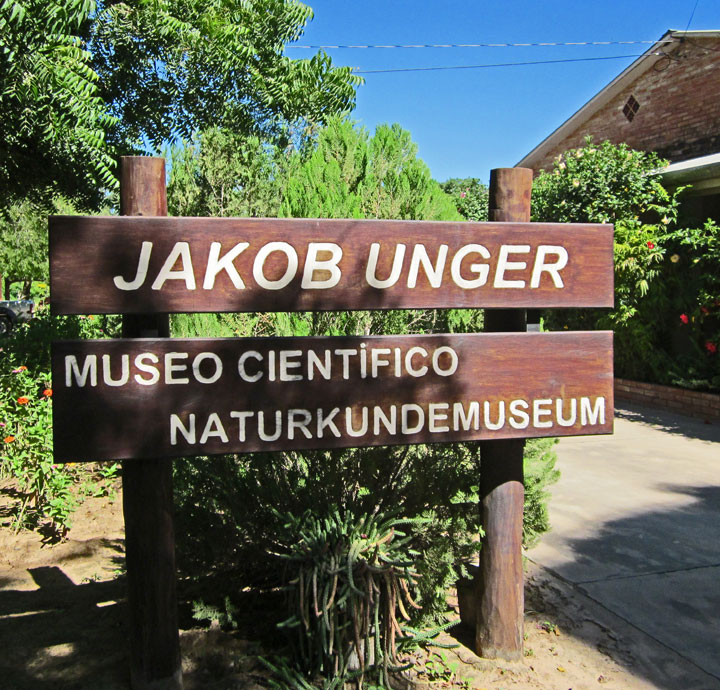
The more conservative groups—those from Kleine Gemeinde, Bergthal and Chortitza—chose
Canada, which promised privileges equal to those previously held in Russia and a
large tract of land to reestablish colonies in Manitoba. The more liberal
groups—those from Molotschna and the Hutterites—chose the United States. Entire
communities such as Alexanderwohl and Bergtal prepared to move as a unit as well
as many individual families from among the other Mennonite villages. They sold
their property, often at reduced prices and worked through the red tape and high
fees of procuring passports.
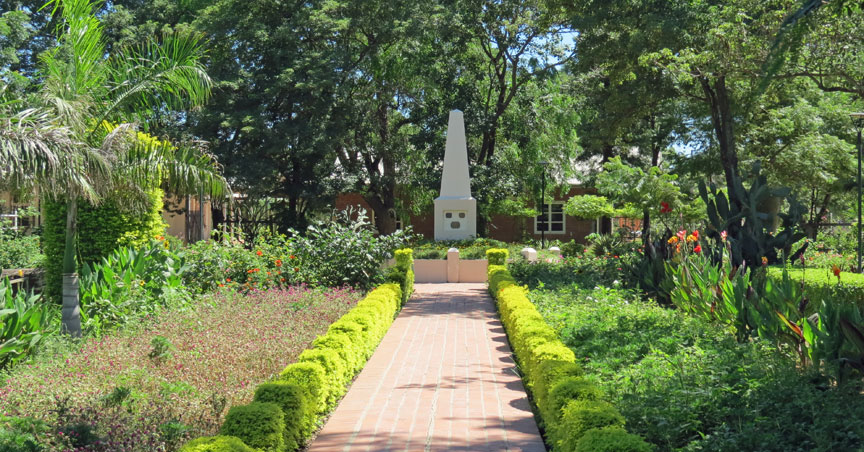
Realizing that 40,000 of Russia's most industrious farmers were preparing to
leave for North America, the Russian government sent Eduard Totleben to the
colonies in May 1874. Meeting with community leaders, he exaggerated the
difficulties that would be encountered in North America and offered an
alternative national service that would not be connected in any way to the
military. His intervention convinced the more liberal Mennonites to stay.
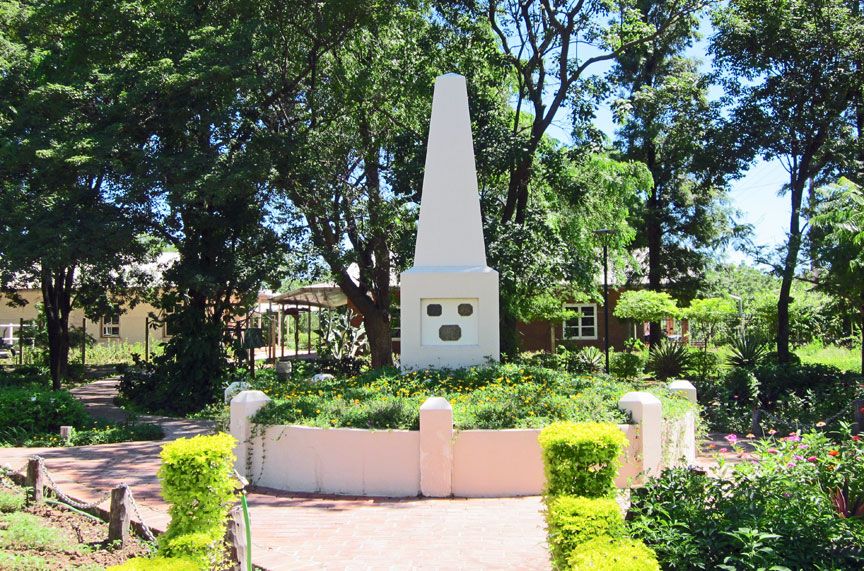
Between 1874 and 1880, of the approximately 45,000 Mennonites in South Russia,
ten thousand departed for the United States and eight thousand for Manitoba. The
settlement of Mennonites, primarily in the central United States, where
available cropland had similarity to that in the Crimean Peninsula, coincided
with the completion of the Transcontinental Railroad in 1869. Others looked
east, and in one of the strangest chapters of Mennonite history, Claas Epp, Jr.,
Abraham Peters and other leaders led hundreds of Mennonites to Central Asia in
the 1880s where they expected Christ's imminent return. They settled in the
Talas Valley of Turkestan and in the Khanate of Khiva. For those who remained in
Russia, the military service question was resolved by 1880 with a substitute
four-year forestry service program for men of military age.
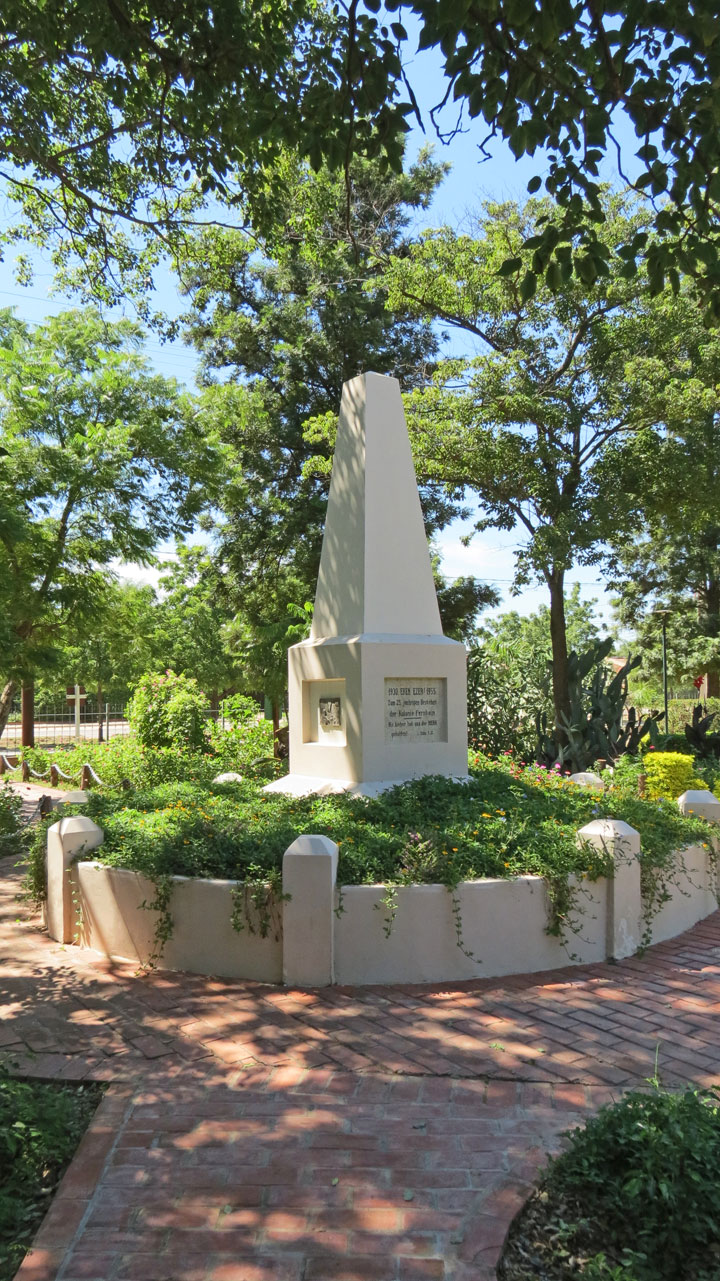
During the period of the 'Great War', the Mennonites in Russia were well
advanced socially and economically. There existed many large agricultural
estates and business entities controlled by Mennonite interests. They had a
reputation for outstanding efficiency and quality and were noted across Russia
for their agricultural and organizational abilities. The precedent of
non-resistant national service had been established years before and the
Mennonites therefore had a system to handle military service requests at the
outbreak of war. During World War I, 5000 Mennonite men served in both forestry
and hospital units and transported wounded from the battlefield to Moscow and
Ekaterinoslav hospitals. The Mennonite congregations were responsible for
funding these forms of alternative service, as well as supporting the men's
families during their absence, a burden of 3.5 million rubles annually. During
this time there was a progressive breakdown in the autonomy of the Mennonite
colonies and social and financial pressure began to take their effect on the
Mennonite people and their institutions. Property and possessions began to be
confiscated for the war effort and certain industrial complexes turned to
military production (some voluntary). Much of the Mennonite hope at that time
was based on the preservation of the existing Russian Provisional Government.
However, as the war progressed the social tide turned against the existing power
structure and Russia began a march toward structural discord.
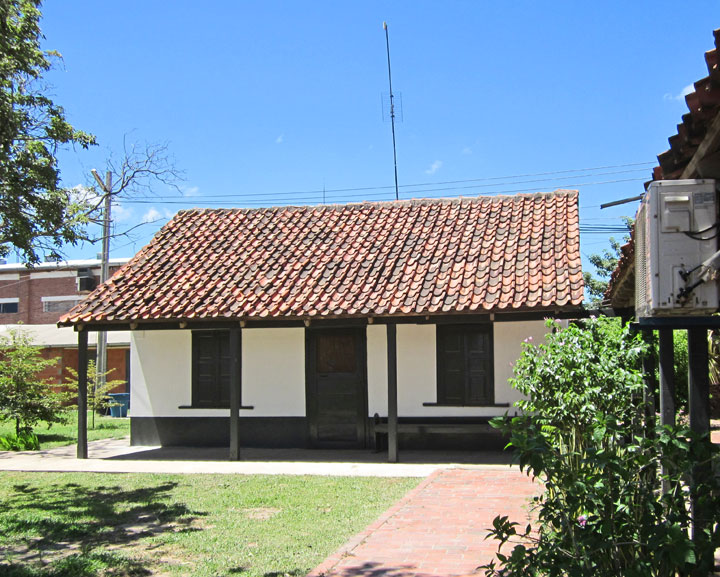
Mennonite building in Chaco
The chaos that followed the collapse of the Russian Provisional Government was
devastating to much of Ukraine, including the Mennonite colonies. The Red and
White armies moved through the region, confiscating food and livestock. Nestor
Makhno's anarchist army generally targeted Mennonites because they were thought
of as "Kulaks" and an entity generally more advanced and wealthy than the
surrounding Ukrainian peasants. The Mennonites Germanic background also served
to inflame negative sentiment during the period of revolution. It is also
rumored that Makhno himself had served on a Mennonite estate in childhood and
harbored negative feelings based on treatment he received while employed there.
Hundreds of Mennonites were murdered, robbed, imprisoned and raped during this
period, and villages including (and around) Chortitza, Zagradovka and Nikolaipol
were damaged and destroyed. Many more lives were lost to typhus, cholera and
sexually transmitted diseases, spread by the armies warring throughout the
colonies.
Based on the tragedy unfolding around them, some of the avowed pacifist
Mennonites turned to self defense and established militia units (Selbstschutz)
to ward off raiding forces with the help of the German Army. While generally
regarded as a failure of spiritual commitment by many within the community
(currently and at the time) the forces initially achieved some military success
in defending Mennonite colonies and families while the communities tried to
escape and/or relocate. Ultimately the self defence militia was overwhelmed once
Makhno's anarchists aligned themselves with the Red Army early in 1919. While
the resistance certainly helped defend Mennonite communities against initial
attacks, it may also have served to inflame some of the atrocities that
followed. After this period many Mennonites were dispossessed and ultimately
their remaining properties and possessions were nationalized (collectivization)
by the Soviet authorities.
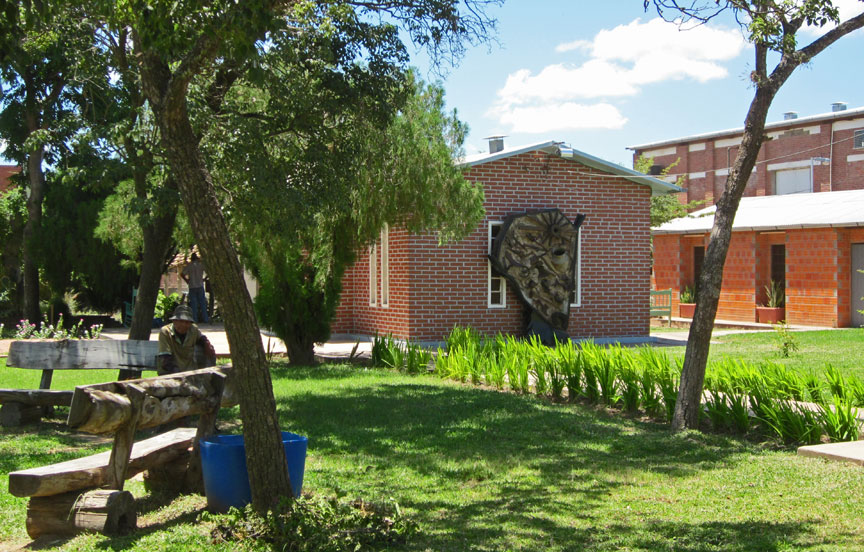
history museum
Mennonites of Molotschna sent a commission to North America in the summer of
1920 to alert American Mennonites of the dire conditions of war-torn Ukraine.
Their plight succeeded in uniting various branches of Mennonites to form
Mennonite Central Committee in an effort to coordinate aid.
The new organization planned to provide aid to Ukraine via existing Mennonite
relief work in Istanbul. The Istanbul group, mainly Goshen College graduates,
produced three volunteers, who at great risk entered Ukraine during the ongoing
Russian Civil War. They arrived in the Mennonite village of Halbstadt in the
Molotschna settlement just as General Wrangel of the White Army was retreating.
Two of the volunteers withdrew with the Wrangel army, while Clayton Kratz, who
remained in Halbstadt as it was overrun by the Red Army, was never heard from
again.
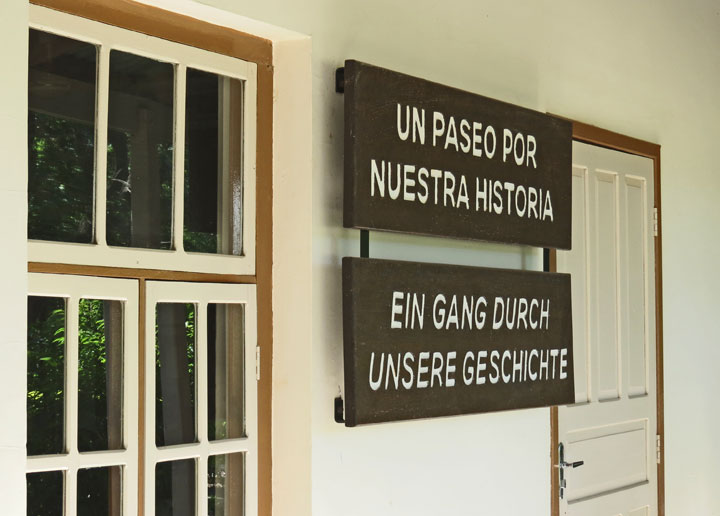
a tour through the Mennonite history
A year passed before official permission was received from the Soviet government
to do relief work among the villages of Ukraine (see Russian famine of 1921).
Kitchens provided 25,000 people a day with rations over a period of three years
beginning in 1922, with a peak of 40,000 servings during August of that year.
Fifty Fordson tractor and plow combinations were sent to Mennonite villages to
replace horses that had been stolen and confiscated during the war. The cost of
this relief effort was $1.2 million.
As conditions improved, Mennonites turned their attention from survival to
emigration. Though the New Economic Policy appeared to be less radical than
previous Soviet reforms, thousands of Mennonites saw no future under the
communists. After years of negotiation with foreign governments and Moscow,
arrangements were made for emigration to Canada, Paraguay and Argentina. Because
Canada had not recognized the Soviet government, Moscow would not deal with them
directly. Emigrants bound for Canada were processed through Riga. Those who
could not pass the medical exam—usually because of trachoma—were allowed to stay
in Germany and Southampton in England until they were healthy. By 1930,
twenty-one thousand Mennonites had arrived in Canada, most on credit provided by
the Canadian Pacific Railway.
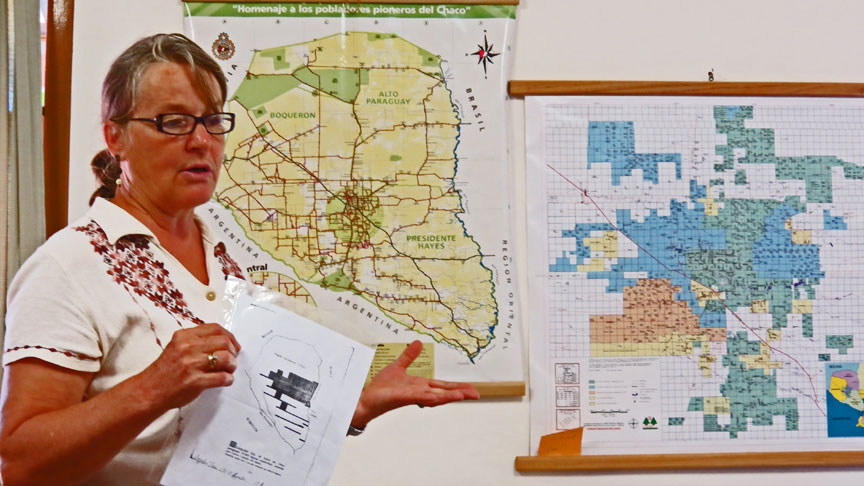
pointing to the places where the Mennonites settled in Chaco
A group of Mennonites from western Siberia who subsequently settled along the
Amur in unrealized hopes of better living conditions, escaped over the frozen
river to Harbin, China. A few hundred were allowed entry into California and
Washington. The majority remained as refugees until the Nansen International
Office for Refugees of the League of Nations intervened and arranged
resettlement in Paraguay and Brazil in 1932.
Those that remained in their home villages were subject to exile to Siberia and
other remote regions east of the Urals. From 1929 to 1940, one in eight men were
removed, usually under the pretext of political accusations, to labor camps from
which few ever returned or were heard from again.
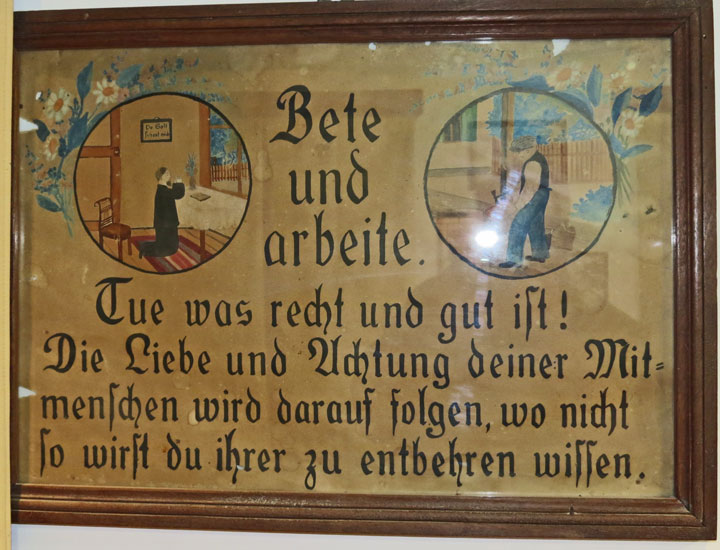
Prayer and Work
With the onset of economic and agricultural reforms, large estates and the
communal land of the Mennonite colonies were confiscated. The next step was to
reduce the model farms by 60% and then another 50% percent—an insufficient size
to support a family. The confiscated land was given to peasants from outside the
Mennonite communities, often communist party members. These new villagers soon
controlled the local government, further confiscating land and rights from the
Mennonite majority by labeling landowners and leaders kulaks and sending them in
exile. The government taxed the remaining landowners so heavily that they could
not possibly produce enough to meet the obligation and their land was
confiscated as payment. As collectivization proceeded, there was some hope that
Mennonites could run their own collective farms, but with the introduction of
Stalin's First Five-Year Plan there was no hope that such a scheme would be
allowed.
Starting in 1918 religious freedoms were restricted. Churches and congregations
had to be registered with the government. Ministers were disenfranchized and
lost all their rights as a citizen. Ministers could not be teachers, which was
the livelihood of many Mennonite pastors. They or their family members could not
join cooperatives or craft guilds. Because of these restrictions, ministers had
a strong incentive to emigrate and few were willing to replace them.
Congregations could no longer do charitable work of any kind, which ended
destroyed the well developed social institutions with the Mennonite colonies.
Villages lost all control of their schools and all religious content prohibited.
Sunday was abolished as a holiday.
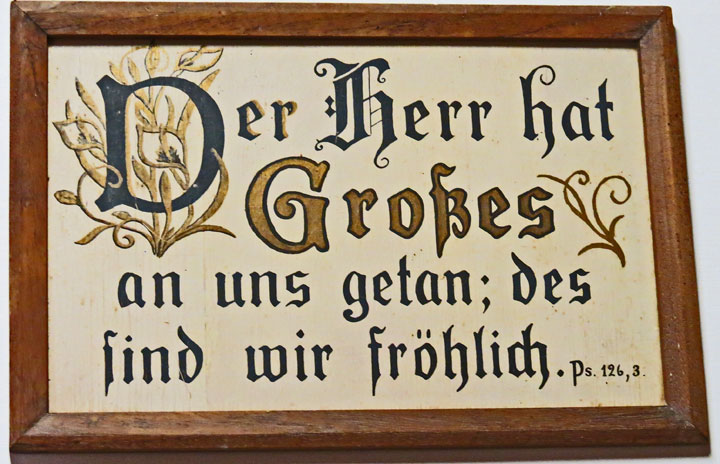
we are happy for what God has done for us
The state of Kansas owes its reputation as a wheat-producing state in large
measure to its early Mennonite settlers. Winter wheat was introduced to Kansas
in 1873. The following year the Mennonites, who had experience with dry land
farming in Russia, quickly took advantage of its characteristics resulting in
rapid expansion of the milling industry in the State.[28] It was planted in the
fall and harvested in the following summer, and was therefore ideally suited to
hot, dry Kansas summers. Today Kansas is a top producer of wheat in America.
Swiss Volhynian Mennonites settled in the Moundridge, Kansas and Pretty Prairie,
Kansas areas. The Swiss Mennonite Cultural and Historical Association tells
their story. Mennonites of Dutch-Prussian descent (who speak a language known as
Plautdietsch, which can be loosely translated as "Low German") settled much of
South Central Kansas.
After 1870 many Russian Mennonites, fearing state influence on their education
systems, emigrated to the Plains States of the US and the Western Provinces of
Canada. They brought with them many of their institutions and practices,
including separate denominations heretofore unseen in North America, like the
Mennonite Brethren. The largest group of Russian Mennonites came out of Russia
after the bloody strife following the various Russian revolutions and the
aftermath of World War I. These people, having lost everything they had known,
found their way to settlements in Alberta, Saskatchewan, Manitoba, British
Columbia and Ontario and in many regions of the United States. Some joined with
previous Mennonite groups, while others formed their own.
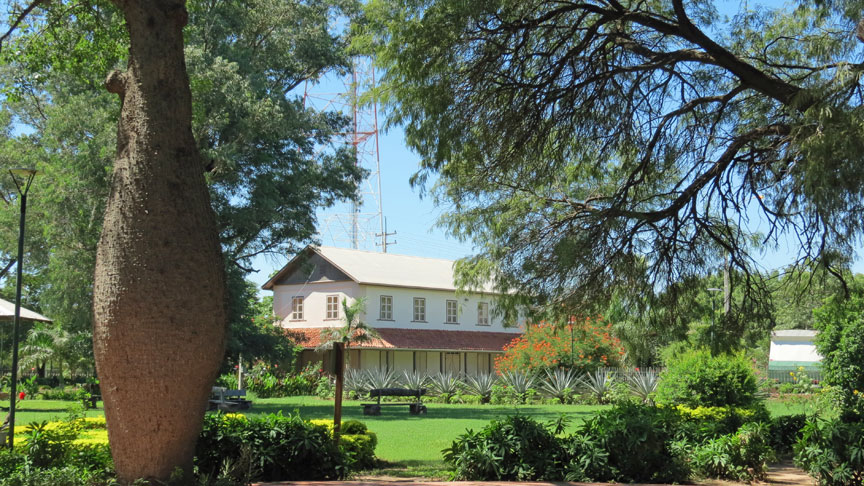
the museum complex in Filadelphia
From North America, many groups, fearing state persecution and searching for a way to "live quietly on the land," have left to form groups in Belize, Mexico and Menno Colony of Paraguay beginning in the 1920s. Fernheim Colony was formed in the 1930s by Mennonites from the Soviet Union seeking a better life in Paraguay. Old Colony Mennonites went from Mexico and Belize in the early 1970s and to Argentina in 1986. A smaller number of Russian Mennonites emigrated as refugees along with the retreating German army after the failed German campaign of World War II. There are 41 Mennonite colonies in Bolivia.
A distinguished writer and historian about the Russian Mennonites in Latin America, especially in Paraguay, is Peter P. Klassen.
Text from Wikipedia

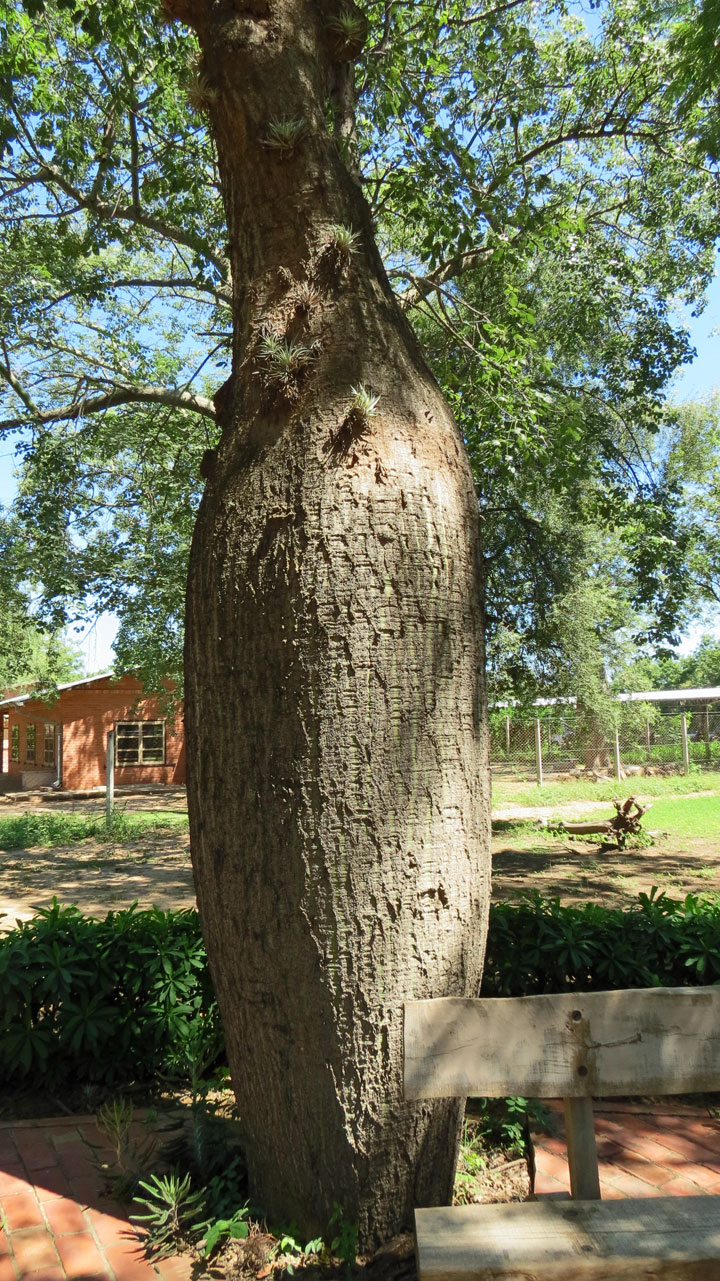
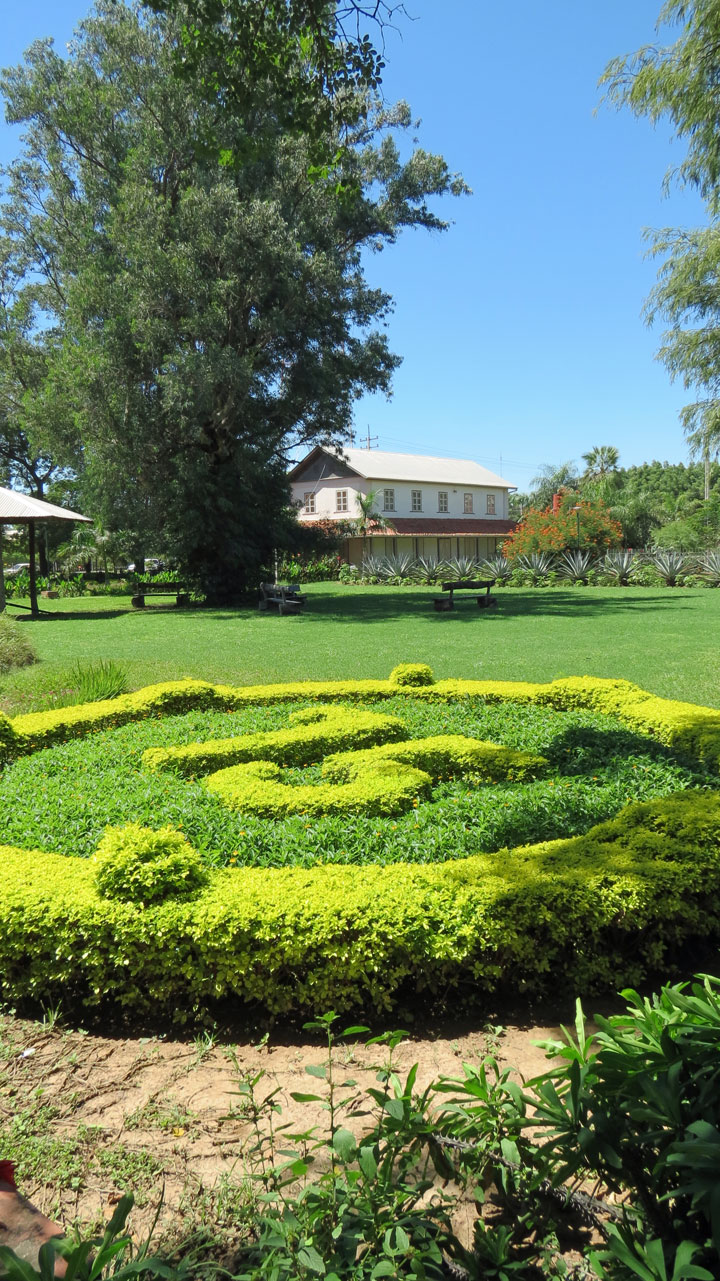
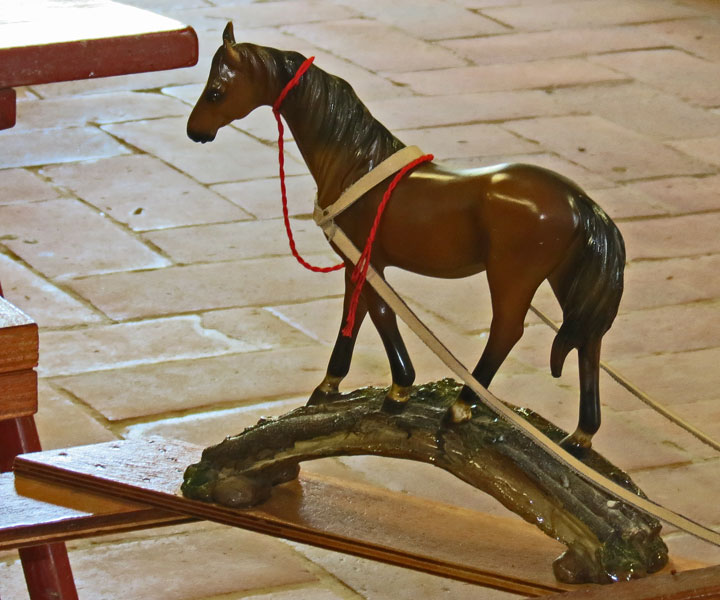
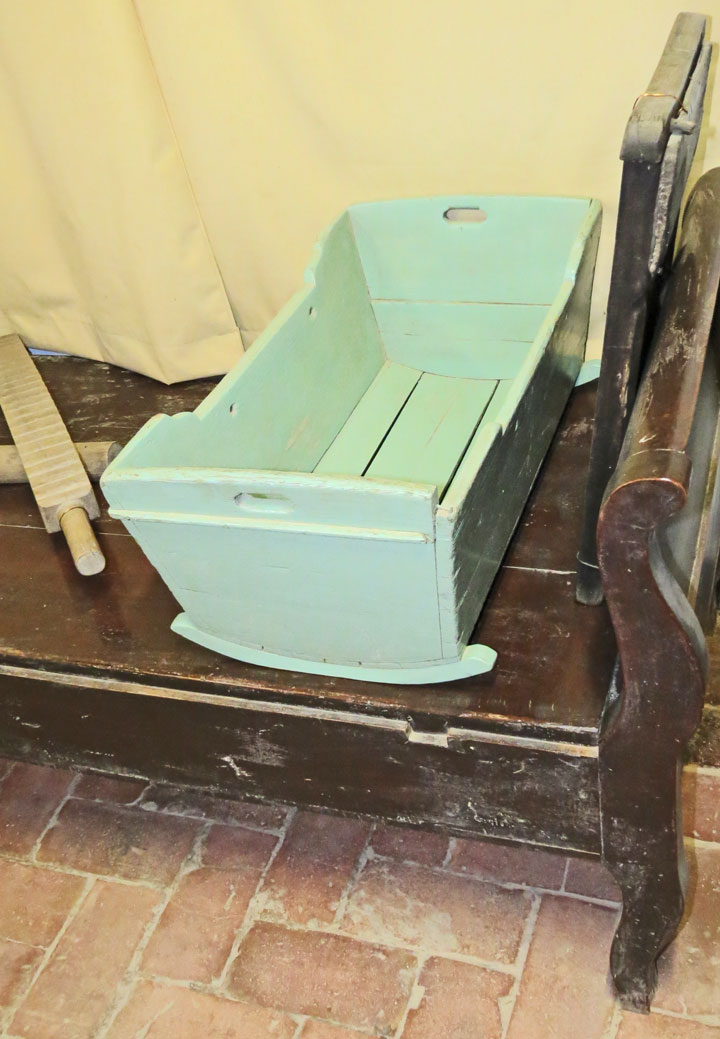

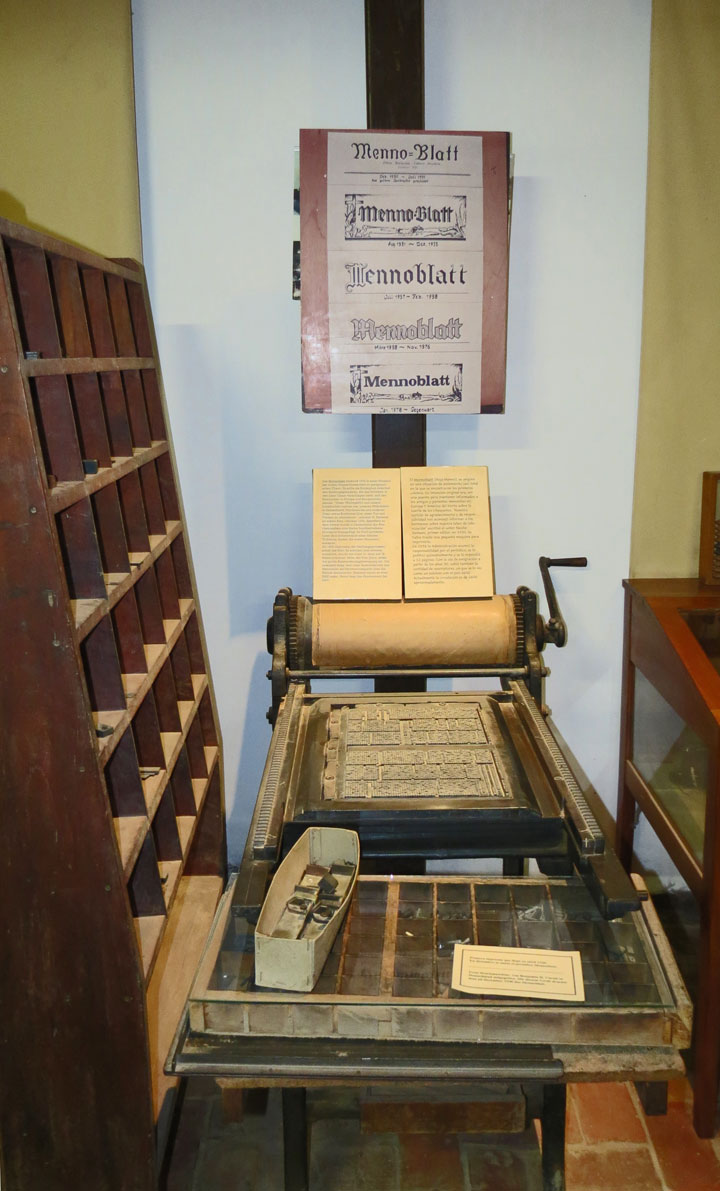
printing the Mennoblatt newspaper
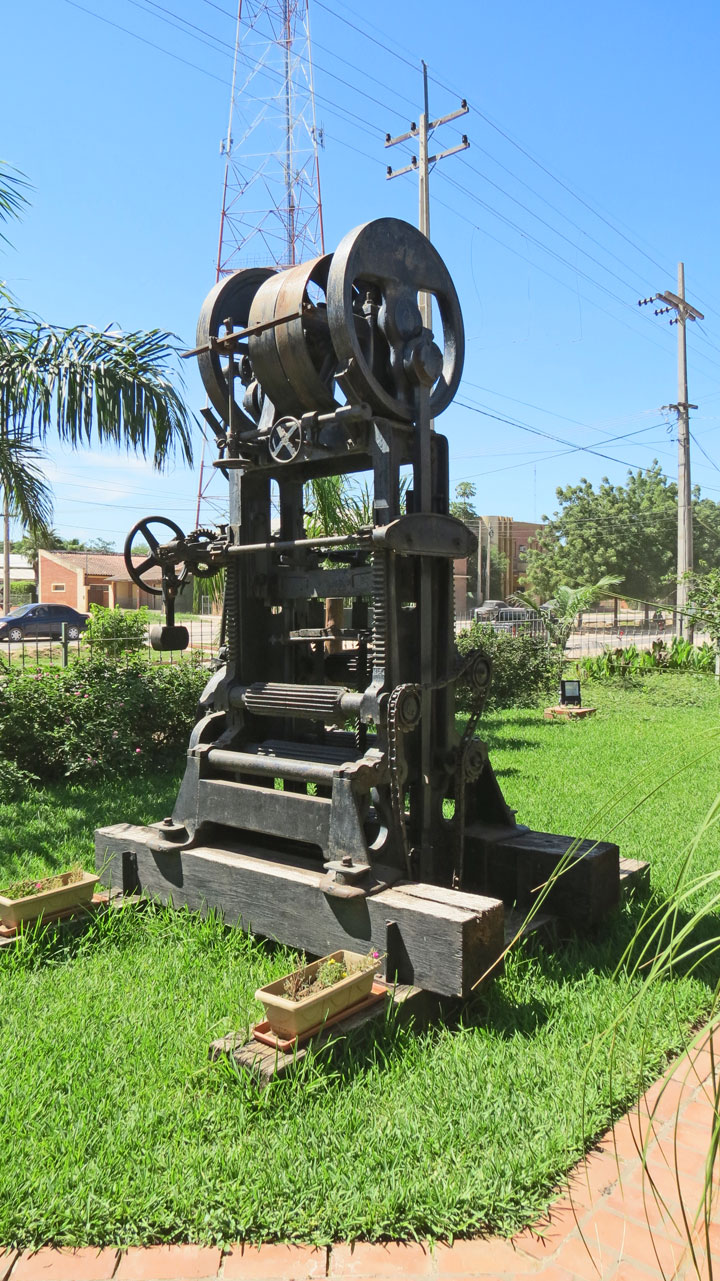
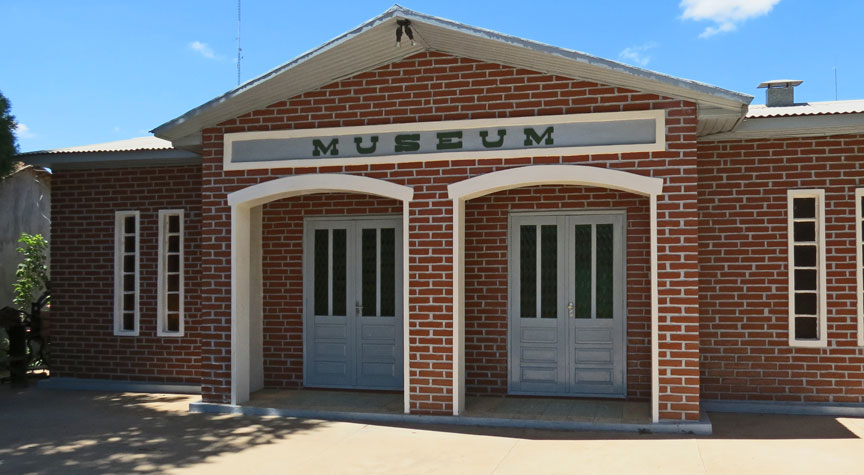
one of the museums

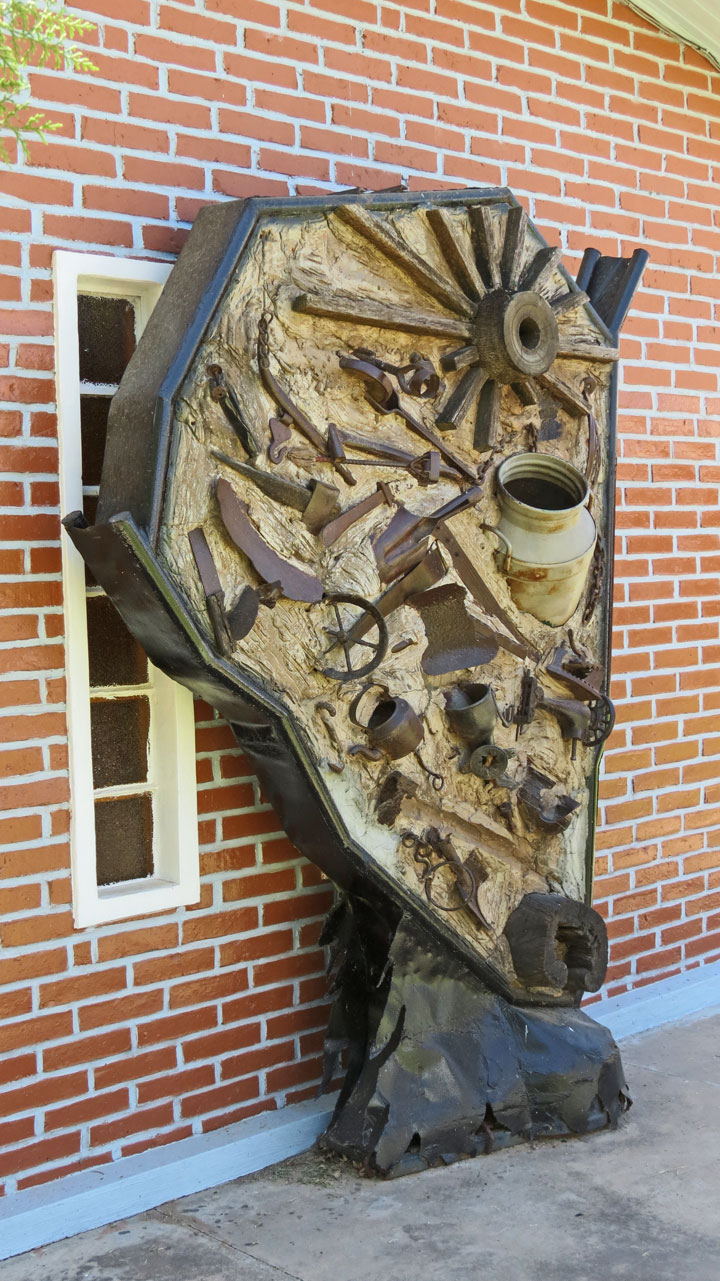
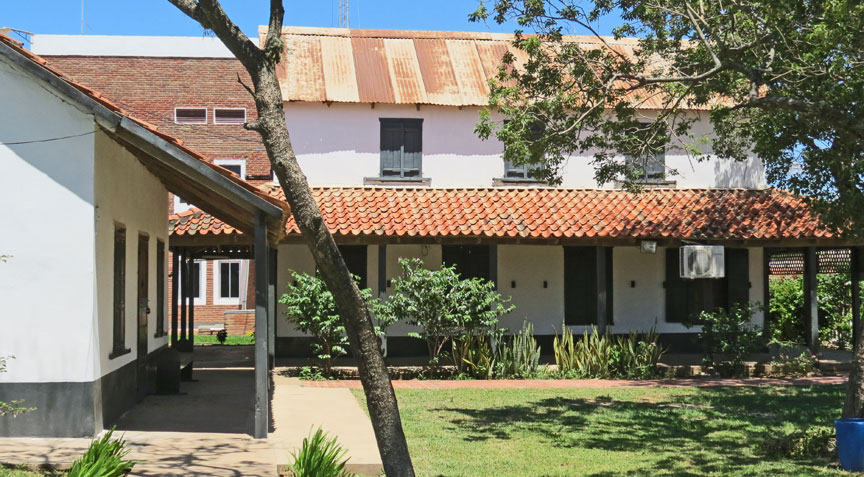
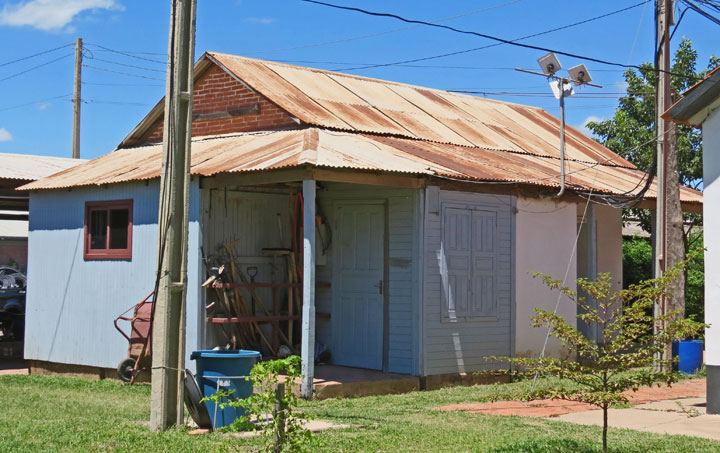
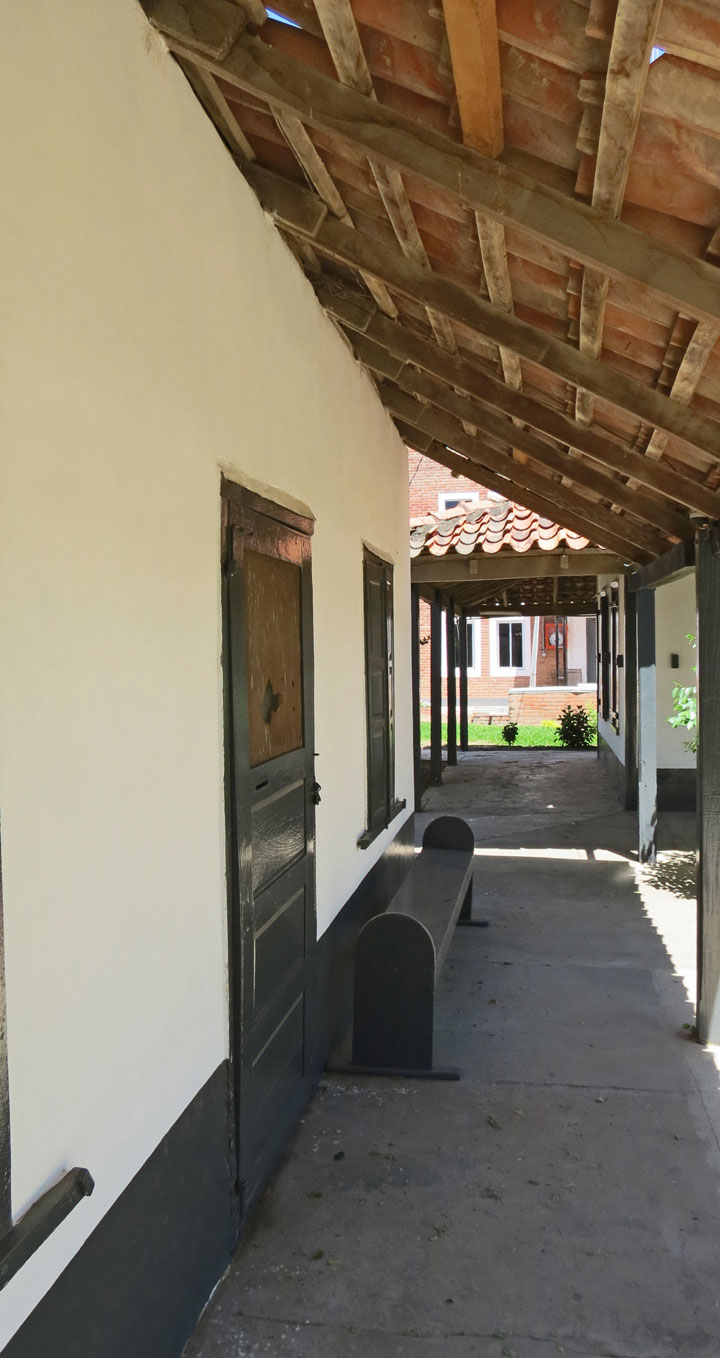
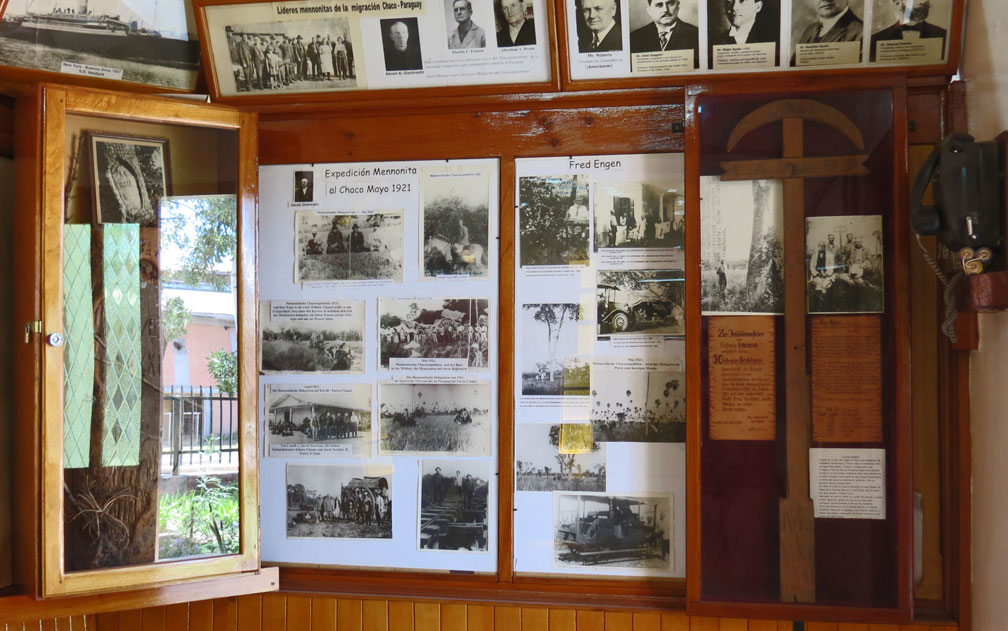
expedition to Chaco in 1921

